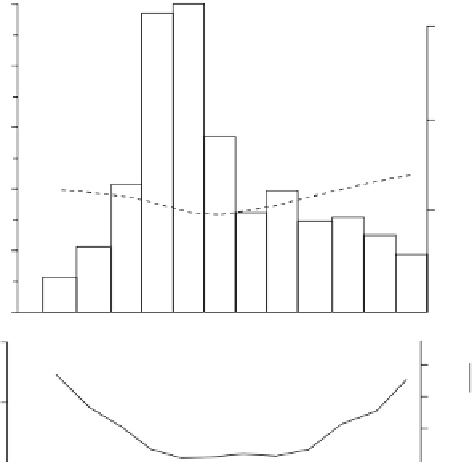Agriculture Reference
In-Depth Information
100
30
80
20
60
40
10
20
J
FM
A
M
J
J
A
S
O
N
D
80
150
100
50
70
Figure 7.1
The mean annual sexual
activity and body weight of mature Boer
goat does (Greyling, 1988).
60
J
FM
J
Months of the year
A
M
J
A
S
O
N
D
rapidly during the last 3 days of the cycle. A consistency
in the interval between peak LH release (preovulatory
surge) and ovulation has been recorded to be approxi-
mately 24 hours confi rming the importance of the role of
LH in the ovulatory mechanism.
The duration of the estrous cycle in goats has been
reviewed. It is evident that extreme variation exists, from
cycles as short as 3 days to cycles as long as 62 days. The
majority of estrous cycles, however, are 19-21 days in
length. Data indicate that short cycles observed early in the
goat-breeding season are predominantly anovulatory and
associated with preovulatory LH peaks of markedly
reduced magnitude. The duration of the estrous cycle in
the mature doe has been set at 20.7 ± 0.7 days, with a high
incidence of short (13 days) and long (25 days) estrous
cycles. A certain proportion of the short cycles can be
related to the season of the year and time interval postpar-
tum. Oestrous cycles in goats have been categorized into
short, medium, and long cycles, at a frequency of 19.7%,
68.8%, and 11.5% and a mean duration of 6.4, 19.8, and
37.5 days for each category, respectively. The phenome-
non of short cycles observed is of interest, and these short
cycles are associated with the formation of short-lived
corpora lutea.
The duration of the estrous period also appears variable
(24-48 hours) in length. Great care should be exercised
when evaluating data reporting on the length of the estrous
period because of the techniques used to detect estrus and
the frequency at which it is measured. Literature is abun-
dant on information regarding the duration of estrus in
different goat breeds, different countries, seasons of the
year, months, etc. For example, estrous cycles and periods
were found to be signifi cantly shorter during periods of the
year with extreme cold-dry and hot-wet periods. The dura-
tion of the estrous period of the Angora doe was found to
be shorter at the onset and end of the breeding season,
compared to the peak months of sexual activity (autumn,
May to July). The most common duration of estrous
periods in goats is reported to be 36 hours, with a variation
ranging from 22-60 hours. The natural duration of estrus
in the Angora doe is quoted as 33.4 hours, compared to
that of the Boer goat doe of 37.4 hours (Riera, 1982;
Greyling, 1988; Jainudeen et al., 2000).
The “male effect” is prominent in does that have been
isolated from males, for example with the introduction of
bucks during the transitional period (time from the anes-
trous to the breeding season). The ovarian response of
anovular does is stimulated by an androgen-dependent
pheromone secretion of the buck. It is generally accepted
that the “male effect” is responsible for the acceleration of
the occurrence of estrus and could also have an infl uence
in shortening the duration of the estrous period in the doe























































